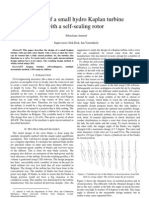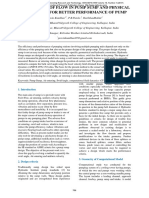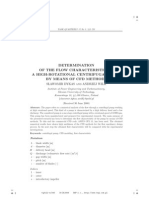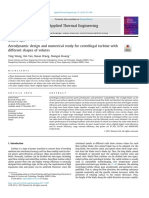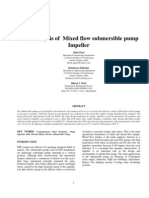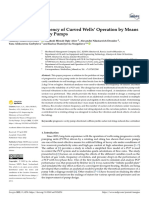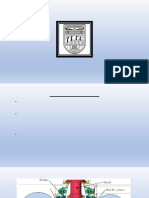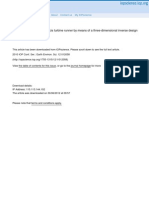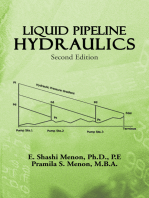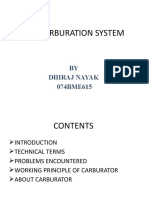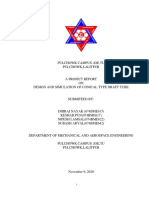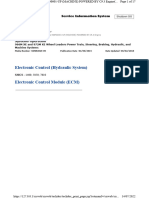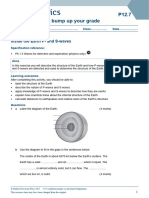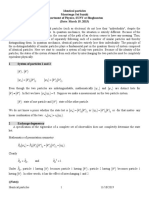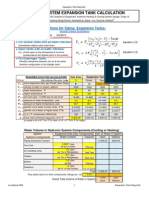Experimental and CFD Analysis of Mixed Elbow Draft Tube and Comparative Analysis With Simple Elbow Draft Tube
Experimental and CFD Analysis of Mixed Elbow Draft Tube and Comparative Analysis With Simple Elbow Draft Tube
Uploaded by
Dhiraj NayakCopyright:
Available Formats
Experimental and CFD Analysis of Mixed Elbow Draft Tube and Comparative Analysis With Simple Elbow Draft Tube
Experimental and CFD Analysis of Mixed Elbow Draft Tube and Comparative Analysis With Simple Elbow Draft Tube
Uploaded by
Dhiraj NayakOriginal Title
Copyright
Available Formats
Share this document
Did you find this document useful?
Is this content inappropriate?
Copyright:
Available Formats
Experimental and CFD Analysis of Mixed Elbow Draft Tube and Comparative Analysis With Simple Elbow Draft Tube
Experimental and CFD Analysis of Mixed Elbow Draft Tube and Comparative Analysis With Simple Elbow Draft Tube
Uploaded by
Dhiraj NayakCopyright:
Available Formats
International Journal for Research in Engineering Application & Management (IJREAM)
ISSN : 2454-9150 Vol-04, Issue-03, June 2018
Experimental and CFD Analysis of Mixed Elbow
Draft Tube and Comparative Analysis with
Simple Elbow Draft Tube
Chaman Pal
Assistant Professor, palchaman0310@gmail.com
T. Gulshan, Shashi Singh, Daleshwar, Nisbat Ali, Chandan Mundhra
UG Students, Department of Mechanical Engineering, SER, ITM University, Naya Raipur (C.G.)
Abstract - The draft tube is one of the essential components in hydraulic reaction turbines. Its function is to create
positive suction pressure utilizing unused kinetic energy at the exit of turbine runner and hence to increase the effective
net head on turbine unit. The energy recovery depends on the design of draft tube. The optimum performance of draft
tube is an important aspect in the design of hydraulic turbine, which can be achieved by varying the shape and size of
draft tube. Amendment of design is made by changing the hydraulic parameters of suction cone, elbow and exit
diffuser. The recovery of kinetic energy leaving the runner determines the performance of draft tubes. The cross-
sectional area at exit of draft tube is dependent of length and angle of diffuser and must be preferred to ensure
maximum recovery with minimum loss. In this paper, the CFD analysis of Mixed Elbow draft has been performed and
results for the same are compared with experimental reading and which are found within the limit and also compare
the experimental and CFD result with simple elbow draft tube.
Keywords: - Draft tube, reaction turbine, hydraulic parameter, CFD, efficiency, energy, and elbow.
I. INTRODUCTION specific speed. The cone angle is not to exceed 80. For
greater value of the cone angle it is seen that the flowing
The efficiency of hydraulic turbine depends on the body of water may not touch the sides of the draft tube
performance of its each component i.e. casing, stay ring, (Leaving the boundary). This will lead to the eddy
distributor, runner and draft tube. The draft tube, which formation bringing down the efficiency of the draft tube.
converts the kinetic energy coming out of the runner into
pressure energy, is an important component of the turbine. Simple Elbow Draft Tube -The draft tube consists of
The hydraulic characteristics of any draft tube depend on its extended elbow type tube used when turbine has to be
shape and dimensions and the flow pattern at its entrance placed close to tail race. It helps to cut down the cost of
(7). The increase in length of draft tube increases the excavation and their exit diameter should be as large as
frictional losses and thus reduces the draft tube efficiency. possible to recover kinetic energy at the outlet of the
Similarly, the increase in diffuser angle will result in flow runner. Such draft tubes are approximately 60% efficient.
separation at the walls of draft tube and eddies may Elbow Draft Tube with Varying Cross Section - This is
generate in the flow passage, which further increase the further improvement of Simple Elbow Draft Tube. The
losses and reduce the efficiency. outlet of draft tube should be situated below the tail race.
In a mixed flow reaction turbine, kinetic energy from
runner is up to 15 % whereas in low head and high speed
axial flow turbines, Kinetics energy leaving the runner may
go up to 50 % of total energy. The recovery of kinetic
energy is achieved by increasing the cross sectional area of
the draft tube in flow direction. Initially, the straight conical
tubes with inlet and outlet area of different cross – section
were used.
Types of Draft Tube The shape and velocity distribution at the inlet are the two
main factors that affects the performance of the draft tube.
Simple Conical Draft Tube - The draft tube has the shape Traditionally, the design of this paper, an attempt has been
of a frustum of a cone. This is generally provided for low
15 | IJREAMV04I033907 DOI : 10.18231/2454-9150.2018.0292 © 2018, IJREAM All Rights Reserved.
International Journal for Research in Engineering Application & Management (IJREAM)
ISSN : 2454-9150 Vol-04, Issue-03, June 2018
made for design automation of modelling of draft tube even fail to produced desired power. The study of flow
using Creo parametric and computational software. The use patterns at inlet is very important for the effective
of computational fluid dynamics continues to grow due to is knowledge about the performance of draft tube. In this
flexibility and cost-effectiveness. A CFD-based design can study, we have discussed the principle of draft tube and its
further be aided with a robust and user-friendly types through literature review. The parameter affecting the
optimization framework theory and engineering. performance of draft tube are also discussed with the help
of researches carried out earlier. The type of methods
An optimum design of draft tube is found out by using CFD
involved in the analysis of performance of draft tube are
as a tool. Assuming suitable dimensions for making Initial
also considered from the literature available (11).
design of draft tube. The optimum performance of draft
tube is an important aspect in the design of hydraulic The determination of optimum shape and dimension of the
turbine, which can be achieved by varying the shape and draft tube and its element is a very difficult problem and
size of draft tube. The recovery of kinetic energy leaving has not been solved until now. The height of curved draft
the runner determines the performance of draft tubes. The tube has a great influence on the efficiency and power
cross-sectional area at exit of draft tube is dependent of output of turbine. Generally, there is non-uniform
length and angle of diffuser and must be chosen to ensure distribution of velocity at entrance section of draft tube and
maximum recovery with minimum loss. the flow has certain amount of vorticity. Moreover,
asymmetric flow in initial suction cone gives rise to flow
Mixed elbow type draft tubes gives better efficiency in
separation even with cone angle 2α at which flow
comparison to simple elbow draft tubes because of more
separation should not occur. The purpose of exit diffuser is
recovery of vortex flow coming out of runner. In this paper,
to connect the elbow with the tail race with further recovery
the numerical simulation of various draft tube is done using
of pressure from flow downstream of an elbow. Since it is
CFD code ANSYS CFX 14.5 for different length and
diffusing in shape both in plan and in elevation view, care
diffuser shape of the draft tube. The performance of draft
should be taken by designer while designing this part to
tube is analysed by calculating head loss, head recovery
minimize the separation and hence the back pressure of
coefficients and efficiency of draft tube from simulation
flow. [1], [7]. Hydraulic losses in draft tube suction cone
results. As well as the proper experimentation results have
depends on several data like divergence angle 2Ø, wall
been compared by fabrication and experimentation on the
roughness, relative area at the inlet (F2) and outlet (Feo) and
different prototypes.
characteristic of flow at entrance of draft tube. Generally,
II. LITERATURE REVIEW these days a convergent-divergent kind of elbow designs
are adopted with initial part as divergent and remaining part
Performance of hydraulic component depends on the design
with slight convergent to minimize the hydraulic losses
of passage from where the fluid would be flowing. To
induced due to separations and eddies generated in the
design an optimum draft tube is a tough task since several
curvatures of draft tube elbow (i.e. on inner surface) [5].
kind of flow phenomenon takes place simultaneously inside
it at BEP and at off design conditions. Gubin, 1973 [1] had A new Reynolds-averaged Navier-Stokes (RANS)
carried out extensive study to examine the flow turbulence model is developed in order to correctly predict
characteristic downstream of runner for reaction turbines. the mean flow field in a draft tube operating under partial
From this study it was observed that the flow downstream load using 2-D axisymmetric simulations. It is shown that
of reaction type runner is having certain amount of swirling although 2-D axisymmetric simulations cannot model the 3-
[2], [3]. In mixed flow reaction turbines, kinetic energy D unsteady features of the vortex rope, they can give the
from runner is up to 15% whereas in low head and high average location of the vortex rope in the draft tube.
speed axial flow turbines, kinetic energy leaving the runner Nevertheless, RANS simulations under predict the turbulent
may go up to 50% of total input energy. The recovery of kinetic energy (TKE) production and diffusion near the
kinetic energy is achieved by increasing the cross-sectional centre of the draft tube where the vortex rope forms,
area of the draft tube in the flow direction. The recovery of resulting in incorrect calculation of TKE profiles and,
the kinetic energy of axial and rotational flow can be best hence, poor prediction of the axial velocity. Based on this
achieved in bell mouth tubes. The use of such tubes for observation, a new k ε turbulence RANS model taking into
large runner diameters has again restriction due to support account the extra production and diffusion of TKE due to
problem of such large dimensions and weight. All these coherent structures associated with the vortex rope
problems are overcome by elbow draft tube for large formation is developed. The new model can successfully
diameter hydraulic turbines [3, 4]. predict the mean flow velocity with significant
improvements in comparison with the realizable k ε model.
The draft tube is one of the important components in a
This is attributed to better prediction of TKE production
hydraulic mixed and reaction turbines. Without this the
and diffusion by the new model in the draft tube under
pressure at the outlet could drop as a result of lack of water
partial load. Specifically, the new model calculates 31%
which may adversely affect the efficiency of plant and may
16 | IJREAMV04I033907 DOI : 10.18231/2454-9150.2018.0292 © 2018, IJREAM All Rights Reserved.
International Journal for Research in Engineering Application & Management (IJREAM)
ISSN : 2454-9150 Vol-04, Issue-03, June 2018
more production and 46% more diffusion right at the shear Tab.1: Initial Non-Dimensional Design parameters of
layer when compared to the k ε model [12]. suction cone and exit diffuser (5).
Draft tubes are used to increase performance in spouted Non-Dimensional Parameter Value
beds. Performance of these tubes depends on its geometry D3/Di 0.696
and location. CFD modelling of bed pro- vide the best D2/Di 0.904
condition. In this work a CFD modelling technique is used hsc/Di 1.193
to optimize draft tube geometry. First, model accuracy was Be/Di 1.728
assessed by comparing the results with experimental Bd/Di 1.904
results. After it became clear that the model works, it was hd/Di 0.646
used to optimize the designing of spouted bed. The Ld/Di 2.041
Eulerian–Eulerian multi-fluid modelling approach was α 9.50
applied to predict gas–solid flow behaviour. The results
present that optimized selection of draft tubes lead to
Design of a simple elbow was prepared by taking
uniform distribution of particle velocity and it can increase dimension of laboratory draft tube and mixed elbow draft
also particles circulating [13]. tube was prepared by according to inlet diameter of simple
A design optimization study of an elbow type draft tube draft tube and by using non dimensional parameters from
based on the combined use of Computational Fluid tab.-1. Design of both draft tube taking considerations of
Dynamics (CFD), design of experiments, surrogate models height, length and bend condition of laboratory setup. Also
and multi-objective optimization is presented in this study. a convergent-divergent hybrid elbow design adopted with
The geometric variables that specify the shape of the draft an assumption of optimal law of variation of cross sectional
tube are chosen as input variables for surrogate models and area as function of length for an elbow. The transition from
the pressure recovery factor and the head loss are selected circular to rectangular cross section of an elbow is
as output responses. It is determined that, pressure recovery accomplished by intermediated oval cross-sections.
factor, which is the main performance parameter, can be From [4] it is confirmed that there is specific importance of
increased by 4.3%, and head loss can be reduced by 20% each and every component of draft tube to the performance
compared to the initial CFD aided design [14]. of a turbine unit. Keeping this thing in mind, a new
III. METHODOLOGY approach was evolved in which it was decided to modify
each part individually and to check the performance of draft
As per the client’s specification, dimensions for draft tube tube by combining them with several permutations and
have been decided and 2D drawing for the same has been combinations.
prepared as shown in figure. The specification of model
turbine for which optimum design of draft tube is required GEOMETRIC MODELLING & BOUNDARY
is Tabulated from laboratory turbine specification. Various CONDITION
dimensions of elbow type draft tube are shown in Fig.2 and Design automation of modelling of draft tube using Creo
the non-dimensional parameters of initial draft tube design parametric and ICEM CFD is used for CFD analysis of
are tabulated in Tab.1. both the draft tubes. Creo model of draft tube has been
converted in to STEP file and this step file has been
imported in ICEM CFD. In fig-3 show the geometry of
simple elbow draft tube which is similar to laboratory draft
tube. In fig.-4 geometry of mixed elbow draft tube which
are made in workshop by sheet metal and elbow section.
Figure 1
Figure 2- 2D sketch of draft tube with Nomenclatures.
Figure 3- Geometry of simple Elbow draft tube
17 | IJREAMV04I033907 DOI : 10.18231/2454-9150.2018.0292 © 2018, IJREAM All Rights Reserved.
International Journal for Research in Engineering Application & Management (IJREAM)
ISSN : 2454-9150 Vol-04, Issue-03, June 2018
BOUNDARY CONDITION
After meshing the meshed geometry is imported in the
ANSYS CFX pre. In boundary condition inlet mass flow
rate is given 1000 kg/sec and outlet boundary condition is
given 1atm for both the prototypes. The pressure and
velocity distribution have been visualized and are as shown
in figures.
VELOCITY STREAM LINES
In fig.7 and fig.8 velocity distribution are shown and we
find out that velocity at outlet in mixed elbow type draft
tube is very less as compared to simple elbow type of draft
tube.
Figure 4-Geometry of mixed Elbow draft tube
MESH CREATION
In meshing CFD mesh type is selected and fine meshing is
done by using one node tetrahedral elements shown in
figure. The reason for selecting this element is that is gives
the good meshing on curvature parts. Meshing model of
draft tube is shown in figures in the meshed models 54133
nodes and 230965 elements were created for simple elbow
type draft tube and 75627 nodes and 317727 elements for
mixed elbow type draft tube were created.
Figure 7- Velocity contour of simple elbow type draft tube
Figure 5-Meshing of simple Elbow type draft tube
Figure 6- Meshing of mixed Elbow type draft tube Figure 8- velocity contour of mixed elbow type draft tube
18 | IJREAMV04I033907 DOI : 10.18231/2454-9150.2018.0292 © 2018, IJREAM All Rights Reserved.
International Journal for Research in Engineering Application & Management (IJREAM)
ISSN : 2454-9150 Vol-04, Issue-03, June 2018
PRESSURE CONTOURS
Figure 10- Pressure contour of mixed Elbow type draft tube
IV. RESULT & OBSERVATIONS
Figure 9- Pressure contour of simple Elbow type draft tube
After simulation we found that difference between pressure
According to fig.9 and fig.10 we checked that how pressure and velocity at inlet and outlet of simple and mixed elbow
variation importance at every section of draft tube and how type draft tube are given under tab.2. After scrutinize
to optimize the area of draft tube. simulation result we fabricate a mixed elbow type draft tube
with rectangular outlet cross section and experiment the
model in laboratory. In experiment result, we observe that
significant changes the result of performance of Francis
turbine. Result show the importance of draft tube in Francis
turbine and how vital in performance of particular turbine.
Tab.2-Simulation results
Type of draft tube Average velocity(ms-1) Average pressure(bar)
Inlet Outlet
Simple elbow type 7.44 x 10-3 2.35 x 10-3 1.03 X 105
Mixed elbow type with varying cross 6.54 X 10-3 2.26 X 10-3 1.013 X 105
section
Tab 3-Experimentation on lab apparatus (simple elbow type draft tube)
Sr. no. Head Orifice meter pressure(bar) Discharge Load on turbine(kg) Speed Power efficiency
(Bar) rpm kw
H P1 P2 Q W1 W2 N I/P O/P %
1 0.55 0.92 0.42 0.028 0 0 1454 1.51 0.084 55.4
2 0.55 0.92 0.42 0.028 1.24 0.50 1300 1.51 0.075 49.6
3 0.55 0.92 0.42 0.028 2.03 0.75 1222 1.51 0.070 46.6
19 | IJREAMV04I033907 DOI : 10.18231/2454-9150.2018.0292 © 2018, IJREAM All Rights Reserved.
International Journal for Research in Engineering Application & Management (IJREAM)
ISSN : 2454-9150 Vol-04, Issue-03, June 2018
Tab 4-Experimentation on prototype (mixed elbow type draft tube with rectangular cross section)
Sr. no. Head Orifice meter pressure(bar) Discharge Load on turbine(kg) Speed Power efficiency
(Bar) rpm kw
H P1 P2 Q W1 W2 N I/P O/P %
1 0.55 0.92 0.45 0.027 0 0 1414 1.45 0.082 56.2
2 0.55 0.92 0.45 0.027 1.24 0.50 1254 1.45 0.072 49.7
3 0.55 0.92 0.45 0.027 2.026 .75 1190 1.45 0.069 47.2
V. TURBINE SPECIFICATIONS VI. CONCLUSION
Runner outside diameter = 150mm = 0.150 m It is seen from the simulation in draft tube that both
Hub diameter = 78mm = 0.078 m pressure and velocity of draft tube has significant change on
No. Of runner blades = 4 draft tube. From experimental calculation also observe that
No. Of guide vanes = 10 efficiency of both draft tube are changes. From the above
Guide vanes = 230mm = 0.230 m observations and results it can be concluded that the mixed
Brake drum diameter = 200mm = 0.200 m elbow type draft tube poses the improved efficiencies as
compared to conventional simple elbow type draft tube.
Rope diameter = 13mm = 0.013 m
The efficiency of a hydraulic reaction turbine is
Size of orifice meter = 100mm = 0.100 m
significantly affected by the performance of its draft tube.
Area ratio = 0.56
This study also discussed the parameters which affects the
Orifice diameter = 75mm = 0.075 m
performance of draft tube and substantially the turbine and
Discharge Q = √ the power plant. Through the reviews it is found that the
FORMULAS USED CFD can be used as a tool for analysing the performance
Q = Discharge in m³/sec and the flow pattern inside the draft tube.
Q= √
Where, VII. NOMENCLATURE
K = Cd x (p / 4) x d2 x √
Ø - Divergence angle of exit diffuser
K = 0.68 x (p / 4) x 0.0752 2 x 9.81 x 10
Bd- Width of exit diffuser
K = 0. 0396
BEP- Best Efficiency Point
I/P = Input Power in KW
Beo -Width of elbow outlet
I / P = g QH
D2- Diameter of suction cone outlet
Where,
D3- Diameter of suction cone inlet
g = Specific weight of water = 9.81 kN/m3
H -Net head
H = Inlet pressure head reading in meter
he -Height of elbow
H= (Pressure gauge reading) x 10 meter
heo -Height of elbow outlet
H= (1.25) x 10 meter
hloss -Hydraulic losses in draft tube
H = 12.5 meter
hs -Suction head
Output Power in KW
hsc -Height of suction cone
O /P power = Lax -Axial length of an elbow
Where, Ld- Length of exit diffuser
T = Torque = Torque in N – m Le- Length of elbow from axis
T = Net load x effective brake drum radius Nsq- Specific speed
Where, Pa- Atmospheric pressure
n = net loading in Kg P3- Static pressure at draft.
Efficiency of turbine in % =
REFERENCES
[1] Gubin, M.F, “Draft tubes of Hydro-Electric Stations
“Amerind Publishing Co. Pvt. Ltd., New Delhi ,1973.
20 | IJREAMV04I033907 DOI : 10.18231/2454-9150.2018.0292 © 2018, IJREAM All Rights Reserved.
International Journal for Research in Engineering Application & Management (IJREAM)
ISSN : 2454-9150 Vol-04, Issue-03, June 2018
[2] Susan-Resiga, R., Muntean, S., Stein, P.Avellan, F.,” shape optimization of an elbow type draft tube “
Axisymmetric Swirling Flow Simulation of the Draft Hydrogen Energy Publications LLC. Published by
tube Vortex in Francis Turbines at Partial Discharge” Elsevier 2017.
In 24th IAHR Symposium on Hydraulic Machinery
and systems, October 27-31, Foz Do Iguassu, Brazil.
[3] Susan-Resiga, R., Ciocan, G.D., Anton,L., Avellan F.,
“ Analysis of Swirling Flow Downstream a Francis
Turbine Runner” Journal of Fluids Engineering. 177-
189. Vol. 128, January 2006.
[4] Barlit, V.V.,” Hydraulic Turbines (Hydraulic Theory,
Computations and Experimental Investigations)” Vol-
1, Vol-2. Maulana Azad National Institute of
Technology, Bhopal, 2007.
[5] Vishal Soni, “Design development of optimum draft
tube for High head Francis turbine using CFD
“Proceedings of the 37th International & 4th National
Conference on FMFP, IIT Madras, 2010.
[6] Vishnu Prasad, Ruchi Khare and Abhas Chincholikar,
“hydraulic performance of elbow draft tube for
Different geometric configurations using cfd.”
Proceedings of 8th International Conference by
IGHEM, IIT, Roorkee,2010.
[7] Dr. Ruchi Khare, Dr. Vishnu Prasad, Mitrasen Verma”
design optimization of conical Draft tube of hydraulic
Turbine”,IJAEST, March 2012.
[8] Buntić Ogor I., Dietze S., Ruprecht A,” Numerical
Simulation of the Flow in Elbow Draft Tube of
Turbine”, Proceeding of the Third IAHR/ERCOFTAC
Workshop on Draft Tube Flow, Porjus, Sweden, 2005.
[9] Modi P.N., Seth S.M., “Hydraulics and Fluid
Mechanics”, Standard Book House, New Delhi.1991.
[10] Avellan, F.,” Flow investigation in a Francis Draft
tube: The Flindt Project” In 20th IAHR Symposium on
Hydraulic Machinery and systems, 6-9 August,
Charlotte,2001.
[11] Sumeet J. Wadibhasme, Shubham Peshne, Pravin
Barapatre, Santosh Barde, Saurabh Dangore, Shubham
Harde, Prof. Shailendra Daf, “Hydraulic Turbine Draft
Tube: Literature Review”, International Journal of
Science, Engineering and Technology Research
(IJSETR), Volume 5, Issue 3, March 2016.
[12] Hosein Foroutan, Savas Yavuzkurt “An axisymmetric
model for draft tube flow at partial load” Journal of
Hydrodynamics,2015.
[13] S. Moradi, A. Yeganeh, M. Salimi ,” CFD-modeling of
effects of draft tubes on operating condition in spouted
beds” Applied Mathematical Modelling, Elsevier
Publication 2013.
[14] Gizem Demirel, Erdem Acar , Kutay Celebioglu, Selin
Aradag,”CFD-driven surrogate-based multi-objective
21 | IJREAMV04I033907 DOI : 10.18231/2454-9150.2018.0292 © 2018, IJREAM All Rights Reserved.
You might also like
- Numerical Questions - Airbreathing EngineDocument2 pagesNumerical Questions - Airbreathing EngineDhiraj NayakNo ratings yet
- Assignment 1 - Engineering EconomicsDocument15 pagesAssignment 1 - Engineering EconomicsDhiraj NayakNo ratings yet
- Z PurlinDocument25 pagesZ Purlinharishram123456100% (1)
- Lab Manual Electrical Machines Lab PTUKDocument151 pagesLab Manual Electrical Machines Lab PTUKTareq FoQha100% (1)
- TM 20Document10 pagesTM 20Razvan RomanNo ratings yet
- Ijsetr Vol 5 Issue 3 673 676 PDFDocument4 pagesIjsetr Vol 5 Issue 3 673 676 PDFDeepak KashyapNo ratings yet
- Vacuum Journal CFturbo Influence Blade Outlet Angle Centrifugal Pump PerformanceDocument8 pagesVacuum Journal CFturbo Influence Blade Outlet Angle Centrifugal Pump PerformanceEA MQNo ratings yet
- In Uence of Blade Wrap Angle On Centrifugal Pump Performance by Numerical and Experimental StudyDocument9 pagesIn Uence of Blade Wrap Angle On Centrifugal Pump Performance by Numerical and Experimental StudyZain KhanNo ratings yet
- Irjaes V2n1p51y17Document4 pagesIrjaes V2n1p51y17Dhiraj NayakNo ratings yet
- Performance Evaluation of A Bulb Turbine Designed For Ultra-Low Head ApplicationsDocument8 pagesPerformance Evaluation of A Bulb Turbine Designed For Ultra-Low Head ApplicationsЖивотаЛазаревићNo ratings yet
- Design, Analysis and Improvisation of Helical Cross Flow Hydro Kinetic Turbine PDFDocument6 pagesDesign, Analysis and Improvisation of Helical Cross Flow Hydro Kinetic Turbine PDFIJAERS JOURNALNo ratings yet
- Kaplan DesignDocument2 pagesKaplan DesignruralworldNo ratings yet
- Tip-Leakage Flow Loss Reduction in A Two-Stage TurDocument15 pagesTip-Leakage Flow Loss Reduction in A Two-Stage TurAbelio TavaresNo ratings yet
- CFD Analysis of Flow in Pump Sump and Physical Validation For Better Performance of PumpDocument7 pagesCFD Analysis of Flow in Pump Sump and Physical Validation For Better Performance of PumpSujoyDeNo ratings yet
- Design and Performance Curve Generation by CFD Analysis of Centrifugal PumpDocument10 pagesDesign and Performance Curve Generation by CFD Analysis of Centrifugal Pumpبلال بن عميرهNo ratings yet
- KUMASHIRO 2016 IOP Conf. Ser. Earth Environ. Sci. 49 022003Document11 pagesKUMASHIRO 2016 IOP Conf. Ser. Earth Environ. Sci. 49 022003emerson william vidalNo ratings yet
- Applying Computer Aided Designing For Steam Turbine BladeDocument6 pagesApplying Computer Aided Designing For Steam Turbine Blademishranamit2211100% (1)
- Design and Development of Split Case PumpDocument4 pagesDesign and Development of Split Case PumpHasan AdelNo ratings yet
- Design Numerical Analysis and ManufacturDocument9 pagesDesign Numerical Analysis and Manufacturr_dhinagaranNo ratings yet
- Ijciet: International Journal of Civil Engineering and Technology (Ijciet)Document7 pagesIjciet: International Journal of Civil Engineering and Technology (Ijciet)IAEME PublicationNo ratings yet
- Design and Performance Analysis of A 3-D Supersonic ImpulseDocument8 pagesDesign and Performance Analysis of A 3-D Supersonic ImpulseRavichandran SrinivasanNo ratings yet
- CFD Analysis of Performace Charectristics of Centrifugal Pump Impeller To Minimising CavitationDocument7 pagesCFD Analysis of Performace Charectristics of Centrifugal Pump Impeller To Minimising CavitationAndres Cardona MercadoNo ratings yet
- tq312l eDocument10 pagestq312l eanildhakeNo ratings yet
- CFD AnalysisDocument7 pagesCFD AnalysisJournalNX - a Multidisciplinary Peer Reviewed JournalNo ratings yet
- 035 TT015 PDFDocument4 pages035 TT015 PDFjguzman-3No ratings yet
- A Study On The Floating Bridge Type Horizontal Axis Tidal Current Turbine For Energy Independent Islands in KoreaDocument14 pagesA Study On The Floating Bridge Type Horizontal Axis Tidal Current Turbine For Energy Independent Islands in KoreaNisa AhmadNo ratings yet
- Research Paper1Document6 pagesResearch Paper1Mitul PatelNo ratings yet
- Energies 15 04259Document14 pagesEnergies 15 04259Rigoberto José Martínez CedeñoNo ratings yet
- Development of Cross Flow Turbine For Pico HydroDocument9 pagesDevelopment of Cross Flow Turbine For Pico HydroLAURO AUGUSTONo ratings yet
- 1-s2.0-S2590123023001652-main_compressedDocument10 pages1-s2.0-S2590123023001652-main_compressedMUHAMMAD HABIBY AL ASYRAFNo ratings yet
- Akin CFD 2014Document6 pagesAkin CFD 2014sousouNo ratings yet
- Improvement of Flow Behavior in The Spiral Casing of Francis Hydro Turbine Model by Shape OptimizationDocument10 pagesImprovement of Flow Behavior in The Spiral Casing of Francis Hydro Turbine Model by Shape OptimizationDragon NestNo ratings yet
- Second Time PPT Final Year ProjectDocument11 pagesSecond Time PPT Final Year ProjectUtkarsh VashishthaNo ratings yet
- Influence of The ImpellerGuide Vane Clearance Ratio On The Performances of A Nuclear Reactor Coolant Pump - 2022 - Tech Science PressDocument15 pagesInfluence of The ImpellerGuide Vane Clearance Ratio On The Performances of A Nuclear Reactor Coolant Pump - 2022 - Tech Science PressJOHAN SEBASTIAN OCHOA MU�OZNo ratings yet
- Effect of Blade Thickness On The Hydraulic Performance of A Francis Hydro Turbine ModelDocument11 pagesEffect of Blade Thickness On The Hydraulic Performance of A Francis Hydro Turbine ModelMuhd HaziqNo ratings yet
- Design and CFD Analysis of Centrifugal Pump IJERTCONV9IS10007Document5 pagesDesign and CFD Analysis of Centrifugal Pump IJERTCONV9IS10007muhammad faisalNo ratings yet
- Cavitation Optimization For A Centrifugal Pump ImpellerDocument7 pagesCavitation Optimization For A Centrifugal Pump ImpellerHéctor ParrAlNo ratings yet
- Design, Development and Testing of An Impeller ofDocument6 pagesDesign, Development and Testing of An Impeller ofbhaveshlibNo ratings yet
- 10 5923 J Ajfd 20140403 03Document12 pages10 5923 J Ajfd 20140403 03puyang48No ratings yet
- CFD Analysis of Flow Field Development I PDFDocument12 pagesCFD Analysis of Flow Field Development I PDFAmjad NassarNo ratings yet
- Upendra2 PDFDocument7 pagesUpendra2 PDFPALASH KHARENo ratings yet
- Centrifugal PumpDocument3 pagesCentrifugal PumpJournalNX - a Multidisciplinary Peer Reviewed JournalNo ratings yet
- Effect of Impeller Blades Number On The Performance of A Centrifugal PumpDocument10 pagesEffect of Impeller Blades Number On The Performance of A Centrifugal PumpHaner EscorciaNo ratings yet
- Flow Conditioning PLatesDocument8 pagesFlow Conditioning PLatesGeethaNo ratings yet
- Design and Analysis of Centrifugal Pump Impeller Using Ansys FluentDocument4 pagesDesign and Analysis of Centrifugal Pump Impeller Using Ansys FluentAmpera marzelaNo ratings yet
- Study On The Effect of The Runner Design Parameters On 50 MW Francis Hydro Turbine Model PerformanceDocument10 pagesStudy On The Effect of The Runner Design Parameters On 50 MW Francis Hydro Turbine Model PerformanceMuhd HaziqNo ratings yet
- Effects of Blade Discharge Angle Blade Number andDocument13 pagesEffects of Blade Discharge Angle Blade Number andJurun BidanshiNo ratings yet
- Design and Simulation of Francis Turbine Runner For Betan Karnali Hydroelectric Project For Original and Reduced Head ConditionDocument9 pagesDesign and Simulation of Francis Turbine Runner For Betan Karnali Hydroelectric Project For Original and Reduced Head ConditionMuhd HaziqNo ratings yet
- Unsteady CFD Simulation For Bucket Design OptimizaDocument11 pagesUnsteady CFD Simulation For Bucket Design OptimizaXingxing HuangNo ratings yet
- A Review On Design and Flow Simulation in An Axial Flow Hydro TurbineDocument3 pagesA Review On Design and Flow Simulation in An Axial Flow Hydro TurbineAron H OcampoNo ratings yet
- Parametric Design of A Francis Turbine Runner by Means of A Three-Dimensional Inverse Design MethodDocument11 pagesParametric Design of A Francis Turbine Runner by Means of A Three-Dimensional Inverse Design MethodsandeshbhavsarNo ratings yet
- Calculation MethodDocument12 pagesCalculation Methodspalaniyandi100% (1)
- Influence of Blade Inlet Angle On The Performance of A Single Blade Centrifugal PumpDocument15 pagesInfluence of Blade Inlet Angle On The Performance of A Single Blade Centrifugal PumpczhanyunNo ratings yet
- Optimization Design of Savonius Diffuser Blade With Moving Deflector For Hydrokınetıc Cross Flow Turbıne RotorDocument10 pagesOptimization Design of Savonius Diffuser Blade With Moving Deflector For Hydrokınetıc Cross Flow Turbıne RotormotherearthcallsNo ratings yet
- Turbine Design and Its Impact On Energy Harvesting From In-Pipe Hydro SystemsDocument6 pagesTurbine Design and Its Impact On Energy Harvesting From In-Pipe Hydro Systemsraja maneNo ratings yet
- A Parametric Study On The Effect of Casing Treatment Slots On Performance Enhancement of A Single Stage Axial Flow CompressorDocument9 pagesA Parametric Study On The Effect of Casing Treatment Slots On Performance Enhancement of A Single Stage Axial Flow Compressorzhaojiangbin1No ratings yet
- Design and Analysis of A Centrifugal PumpDocument10 pagesDesign and Analysis of A Centrifugal Pumpharsh rikameNo ratings yet
- Meridional Considerations of The Centrifugal Compressor DevelopmentDocument11 pagesMeridional Considerations of The Centrifugal Compressor DevelopmentJun GWan ParkNo ratings yet
- Selection of Optimal Number of Francis Runner Blades For ADocument10 pagesSelection of Optimal Number of Francis Runner Blades For ARanjeetTwaynaNo ratings yet
- PAPERInggris Tubes Michael Wijaya MesfluDocument17 pagesPAPERInggris Tubes Michael Wijaya Mesflueddoarus123No ratings yet
- Mentzos Etal - Parametric Study of A Centrifugal Pump Impeller by Varying The Outlet Blade AngleDocument9 pagesMentzos Etal - Parametric Study of A Centrifugal Pump Impeller by Varying The Outlet Blade AngleAndronikos Filios100% (14)
- Design and Analysis of Mixed Flow Pump ImpellerDocument5 pagesDesign and Analysis of Mixed Flow Pump ImpellerEditor IJTSRDNo ratings yet
- The Carburation SystemDocument12 pagesThe Carburation SystemDhiraj NayakNo ratings yet
- Ce ReportDocument29 pagesCe ReportDhiraj NayakNo ratings yet
- Spring Design: Prepared and Presented By: Manoj AdhikariDocument21 pagesSpring Design: Prepared and Presented By: Manoj AdhikariDhiraj NayakNo ratings yet
- Fixed Dome Type Biogas PlantDocument5 pagesFixed Dome Type Biogas PlantDhiraj NayakNo ratings yet
- Spring Design Ii: Prepared and Presented byDocument11 pagesSpring Design Ii: Prepared and Presented byDhiraj NayakNo ratings yet
- Springs As:, ,, 2, .: TMM II 2078 Assignment 7/MCLDocument6 pagesSprings As:, ,, 2, .: TMM II 2078 Assignment 7/MCLDhiraj NayakNo ratings yet
- Chapter 7 Rate-of-Return AnalysisDocument26 pagesChapter 7 Rate-of-Return AnalysisDhiraj NayakNo ratings yet
- Assignment 2 - Engineering EconomicsDocument9 pagesAssignment 2 - Engineering EconomicsDhiraj NayakNo ratings yet
- Assignment 06bDocument2 pagesAssignment 06bDhiraj NayakNo ratings yet
- Assignment - 8-Contemporary Engineering EconomicsDocument3 pagesAssignment - 8-Contemporary Engineering EconomicsDhiraj NayakNo ratings yet
- Assignment 4 - Contemporary Engineering BookDocument9 pagesAssignment 4 - Contemporary Engineering BookDhiraj NayakNo ratings yet
- Fluid ProjectDocument45 pagesFluid ProjectDhiraj Nayak0% (1)
- A Case Study On Nepal Bank LimitedDocument12 pagesA Case Study On Nepal Bank LimitedDhiraj Nayak100% (2)
- Design and Analysis of Conical Draft TubeDocument31 pagesDesign and Analysis of Conical Draft TubeDhiraj NayakNo ratings yet
- Dwnload Full University Physics With Modern Physics 2nd Edition Bauer Solutions Manual PDFDocument7 pagesDwnload Full University Physics With Modern Physics 2nd Edition Bauer Solutions Manual PDFelijahaw6dunn100% (18)
- Answers: 1.1 Length and TimeDocument34 pagesAnswers: 1.1 Length and TimeL LHNo ratings yet
- The Kinetic Molecular Theory (KMT) Explains The Properties of Gases and Describes The Behavior of GasesDocument3 pagesThe Kinetic Molecular Theory (KMT) Explains The Properties of Gases and Describes The Behavior of GasesLørd Ken M. DilaoNo ratings yet
- Lab # 2Document6 pagesLab # 2Muhammad FarzanNo ratings yet
- Gujarat Technological UniversityDocument2 pagesGujarat Technological Universityyicef37689No ratings yet
- cleaning_chiller_tubes_checklist_final_0421Document1 pagecleaning_chiller_tubes_checklist_final_0421Sérgio Rapozo BorgesNo ratings yet
- EstimateDocument2 pagesEstimatemanishsngh24No ratings yet
- Air Pro Fans IOM - 2999-6Document12 pagesAir Pro Fans IOM - 2999-6corey hamiltonNo ratings yet
- Cable Size CalculationsDocument4 pagesCable Size Calculationsgaurav_chikhalkar007No ratings yet
- Electrochemistry 2024Document62 pagesElectrochemistry 2024shellodkomaNo ratings yet
- ME Sci 8 Q1 0704 SGDocument23 pagesME Sci 8 Q1 0704 SGZyro Jay MonteroNo ratings yet
- Graphical Interpretation of Center of Lift Versus Neutral Point For A 2D AirfoilDocument8 pagesGraphical Interpretation of Center of Lift Versus Neutral Point For A 2D Airfoilmotaz alzoubiNo ratings yet
- Set-Valued Map and Nadler's PrincipleDocument46 pagesSet-Valued Map and Nadler's PrincipleHữu Hiệu ĐoànNo ratings yet
- Electronic Control HidraulicDocument17 pagesElectronic Control HidraulicpricopdanielNo ratings yet
- CM Current Affairs Oct 23 To May 24Document36 pagesCM Current Affairs Oct 23 To May 24AMSNo ratings yet
- SeismicWaves KerboodleDocument4 pagesSeismicWaves Kerboodlekavan.avnishNo ratings yet
- Hooke Law Lab ReportDocument10 pagesHooke Law Lab ReportasifNo ratings yet
- Identical ParticlesDocument23 pagesIdentical ParticlesNitish SoniNo ratings yet
- 2009 S1 Exam SolutionsDocument12 pages2009 S1 Exam Solutions赵一伦No ratings yet
- 10+1 Physics Book-1 (Mathematical Tools, Units & Dimensions) 2020Document112 pages10+1 Physics Book-1 (Mathematical Tools, Units & Dimensions) 2020Kalin Bhayia100% (1)
- Akira Ct-21ni9r 3S10 - ST92195, STV2248, STRG6653Document13 pagesAkira Ct-21ni9r 3S10 - ST92195, STV2248, STRG6653ايهاب فوزيNo ratings yet
- SK Ghosh Anchor Webinar HandoutDocument37 pagesSK Ghosh Anchor Webinar HandoutMikeNo ratings yet
- Straight Line - 1Document6 pagesStraight Line - 1babufatafatiNo ratings yet
- Stability of Retaining WallsDocument12 pagesStability of Retaining WallsDavid KegayaNo ratings yet
- Atoms, Elements and Compounds - NotesDocument30 pagesAtoms, Elements and Compounds - NoteseyaadmohaNo ratings yet
- AHU-03 (Cake Preparation)Document1 pageAHU-03 (Cake Preparation)SeshuNo ratings yet
- Expansion Tank Sizing Calculation (Hydronic System)Document16 pagesExpansion Tank Sizing Calculation (Hydronic System)Edgar Isip Lim100% (12)
- A2 CH 3 Practice TestDocument5 pagesA2 CH 3 Practice Test4hs52zgvd7No ratings yet











